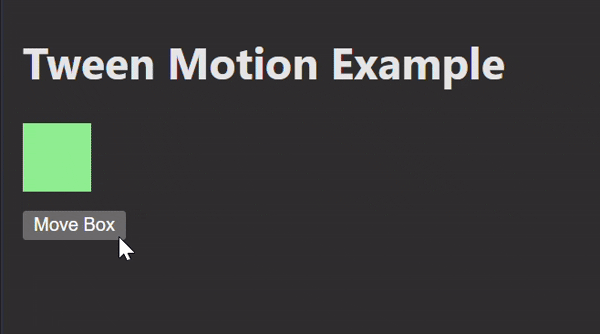
- Svelte - Home
- Svelte - Introduction
- Svelte - Installation
- Svelte - Reactivity
- Svelte - Props
- Svelte - Logic
- Svelte - Events
- Svelte - Bindings
- Svelte - Classes
- Svelte - Styles
- Svelte - Actions
- Svelte - Transitions
- Svelte - Advance Reactivity
- Svelte - Reusing Content
- Svelte - Motion
- Svelte - Advanced Binding
- Svelte - Advanced Transitions
- Svelte - Context API
- Svelte - Special Elements
- SvelteKit Basics
- SvelteKit - Introduction
- SvelteKit - Routing
- SvelteKit - Loading Data
- SvelteKit - Headers
- SvelteKit - Cookies
- SvelteKit - Shared Modules
- SvelteKit - Forms
- SvelteKit - API Routes
- SvelteKit - States
- SvelteKit - Errors
- SvelteKit - Redirects
- SvelteKit Advanced
- SvelteKit - Hooks
- SvelteKit - Page Options
- SvelteKit - Link Options
- SvelteKit - Advanced Routing
- SvelteKit - Advanced Loading
- SvelteKit - Environment Variables
- Svelte Resources
- svelte - Useful Resources
- svelte - Discussion
Svelte - Svelte Motions
Motions in Svelte refer to the animations and transitions that can be applied to elements within a Svelte application. They enhance user experience by making interfaces more dynamic and visually appealing.
What are Tweens?
Tweens are animations that let a value change smoothly from one state to another over a set amount of time. In Svelte, they improve user interfaces by giving visual feedback when values change.
Creating a Tween
To create a tweened motion for your svelte project you can follow the steps mentioned below:
- Import the Tween Class: First, import the Tween class from svelte/motion.
<script>
import { Tween } from 'svelte/motion';
</script>
<script>
import { Tween } from 'svelte/motion';
// Create a tween instance with an initial value of 0
const tween = new Tween(0);
</script>
Key Properties of Tween
- Target: This is a property you can change to show where you want the animation to move.
- current: This is a read-only property that shows you the current animated value.
Additional Options
When creating a tween, you can also specify options like:
- duration: How long the animation lasts (in milliseconds).
- easing: A function that defines how the animation progresses (e.g., linear, ease-in-out).
- delay: Time before starting the animation.
What is a Spring?
A spring in svelte is a type of animation that acts like a real spring. It is great for values that change often because it creates a smoother and more natural movement than regular animations.
Creating a Spring
To create a spring motion for your svelte project you can follow the steps mentioned below:
- Import the Spring Function: First, import the spring function from svelte/motion.
<script>
import { spring } from 'svelte/motion';
</script>
<script>
import { spring } from 'svelte/motion';
// Create a spring with an initial value of 0
const mySpring = spring(0, {
stiffness: 0.1, // Controls how stiff the spring is
damping: 0.25 // Controls how quickly the spring settles
});
</script>
Example
This example shows how to use Svelte's tween class to animate a box's position in response to button clicks.
<!--src/store.js-->
import { tweened } from 'svelte/motion';
import { cubicOut } from 'svelte/easing';
// Create a tweened store for the position
export const position = tweened(0, {
duration: 500,
easing: cubicOut
});
<!-- src/App.svelte -->
<script>
import { position } from './store.js';
function moveBox() {
position.set(Math.random() * 300); // Move to a random position between 0 and 300
}
</script>
<style>
.box {
width: 50px;
height: 50px;
background-color: lightgreen;
position: relative;
margin-bottom:10px;
}
</style>
<main>
<h1>Tween Motion Example</h1>
<div class="box" style="left: {$position}px;"></div> <!-- Use inline style for left position -->
<button on:click={moveBox}>Move Box</button>
</main>
Output
